| Reviews & Columns |
|
Reviews DVD TV on DVD Blu-ray 4K UHD International DVDs In Theaters Reviews by Studio Video Games Features Collector Series DVDs Easter Egg Database Interviews DVD Talk Radio Feature Articles Columns Anime Talk DVD Savant Horror DVDs The M.O.D. Squad Art House HD Talk Silent DVD
|
DVD Talk Forum |
|
|
| Resources |
|
DVD Price Search Customer Service #'s RCE Info Links |
|
Columns
|
|
|
Night of the Werewolf / Vengeance of the Zombies, The
BCI Eclipse // Unrated // January 8, 2008
List Price: $29.98 [Buy now and save at Amazon]
The Night of the Werewolf
The first half of Deimos Entertainment's Spanish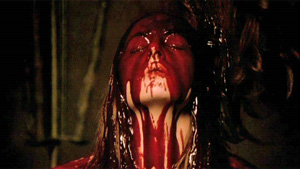 horror double feature is The Night of the Werewolf (El Retorno del Hombre Lobo), the eighth installment in Paul Naschy's long-running and loosely-connected series about the lycanthropic Count Waldemar Daninsky. Naschy himself stepped behind the camera as director to bring this mainstay of 1970s Eurohorror into the '80s, but in stark contrast to the post-modern take on the mythos in An American Werewolf in London and the darkly comedic The Howling that would follow a year later, Naschy's approach instead owes more to the traditional, gothic horror of decades past.
horror double feature is The Night of the Werewolf (El Retorno del Hombre Lobo), the eighth installment in Paul Naschy's long-running and loosely-connected series about the lycanthropic Count Waldemar Daninsky. Naschy himself stepped behind the camera as director to bring this mainstay of 1970s Eurohorror into the '80s, but in stark contrast to the post-modern take on the mythos in An American Werewolf in London and the darkly comedic The Howling that would follow a year later, Naschy's approach instead owes more to the traditional, gothic horror of decades past.
The Night of the Werewolf is in large part a glossier version of Werewolf Shadow, which Naschy had starred in and co-written nearly a full decade earlier. The movie opens at the dawn of the 17th century as the bloodthirsty Countess Elizabeth Bathory (Julia Saly) is sentenced to a slow, agonizing death. Daninsky, her lycanthropic slave, meets a similarly grisly end and is eager to have his torment at long last draw to a close. Daninsky's corpse is left in peace for centuries until a pair of graverobbers remove the silver cross lodged in his chest, reviving the beast and sparking another reign of terror across the Hungarian countryside.
Three nubile aspiring archaeologists stumble upon Daninsky, who remains in human form until the next full moon and has somehow taken to living in a castle. Karen (the breathtakingly beautiful Azucena Hernández) instantly falls for the Count, and her love holds the key to once again ending his curse. Erika (Silvia Aguilar), meanwhile, is fascinated with a different sort of monster, determined to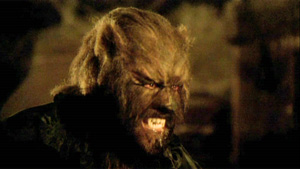 uncover Bathory's tomb and revive the vampiress with the spilled blood of her friends. Bathory and her insatiable minions ravage the countryside and vow to return Daninsky to their thrall, a necessary step in amassing the power to cloak the world in darkness.
uncover Bathory's tomb and revive the vampiress with the spilled blood of her friends. Bathory and her insatiable minions ravage the countryside and vow to return Daninsky to their thrall, a necessary step in amassing the power to cloak the world in darkness.
I have to admit to not thinking much of some of the earlier films in the series when I first saw them years ago, and I'm sure I would've had much the same reaction to The Night of the Werewolf at the time. The pacing is slower and more deliberate than the bulk of the werewolf movies I grew up with, and Daninsky is rarely seen fully transformed. It's really not difficult at all to argue that despite their titles, Werewolf Shadow and The Night of the Werewolf are better described as vampire films than werewolf movies, and they aren't drenched in blood by either standard. Seeing these movies again through somewhat older eyes, I have a much greater appreciation for them now, and The Night of the Werewolf is by far the best of the lot.
The Night of the Werewolf owes much of its success to the look of the film. Naschy and cinematographer Alejandro Ulloa share a keen visual eye, and this film had the luxury of enough time and money to be artful in a way that previous installments lacked. Its earlier moments root the film in a particular time and place -- the blame goes to some bikini-clad, poolside exposition and the girls' arrival by car -- but once the story gets underway, The Night of the Werewolf deftly transforms itself into gothic horror, set entirely in torchlit castles and dusty underground crypts. Change out some of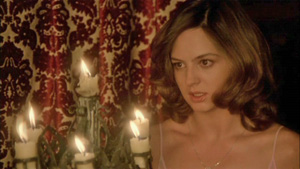 the wardrobe and it could just as easily be taking place a hundred years earlier. Comparisons to Hammer's monster revivals of the '60s are unavoidable but well-deserved, not just in terms of the story and cinematography but the make-up effects as well. The latex and air-bladders that would earn An American Werewolf in London an Oscar for its effects were only a year away, but The Night of the Werewolf prefers grease paint and spirit gum, following the various stages of Daninsky's transformations with time-lapsed camera fades. The look of its vampires has also been improved over Werewolf Shadow, trimming down the cartoonishly long fangs to something more subtle and effective.
the wardrobe and it could just as easily be taking place a hundred years earlier. Comparisons to Hammer's monster revivals of the '60s are unavoidable but well-deserved, not just in terms of the story and cinematography but the make-up effects as well. The latex and air-bladders that would earn An American Werewolf in London an Oscar for its effects were only a year away, but The Night of the Werewolf prefers grease paint and spirit gum, following the various stages of Daninsky's transformations with time-lapsed camera fades. The look of its vampires has also been improved over Werewolf Shadow, trimming down the cartoonishly long fangs to something more subtle and effective.
There are a number of sequences that still hold up exceptionally well today, particularly the revival of Bathory; as blood oozes from a naked, lifeless body suspended above, smoke streams from the stone likeness of the Countess that adorns her tomb. Admittedly, the storytelling has its clumsier moments, some of the film's effects probably looked dated even when The Night of the Werewolf was first released nearly thirty years ago, and its slower pace and restrained violence may bore viewers weaned on bloodier, more brutal movies. To me, at least, The Night of the Werewolf is such a finely crafted homage to classic horror that what might be viewed as shortcomings to some are an essential part of its appeal. Highly Recommended.
Vengeance of the Zombies
In the introduction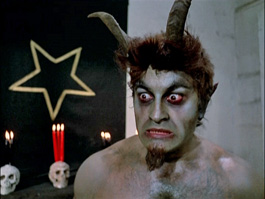 that opens this Blu-ray disc, writer and star Paul Naschy twice describes Vengeance of the Zombies (La Rebelión de las Muertas) as strange, and...yes, "una pelicula extraña" would certainly be one way to put it.
that opens this Blu-ray disc, writer and star Paul Naschy twice describes Vengeance of the Zombies (La Rebelión de las Muertas) as strange, and...yes, "una pelicula extraña" would certainly be one way to put it.
The liner notes in its initial DVD release on these shores described this 1972 slice of Eurocult as a mix of a German krimi and a zombie film. I can't claim to be all that familiar with krimi, but if Vengeance of the Zombies is any indication, it's not too far removed from the Italian giallo. A masked killer on a deranged search for revenge is hunting his prey throughout the English countryside, and with each woman he kills, he adds another member to his arsenal of the walking undead. These are zombies in the classic sense, re-animated by voodoo rather than some sort of cannibalistic plague, and their etherial, dreamlike movements owe more to the Templars in the Blind Dead series than the flesh-eaters of Let Sleeping Corpses Lie. The plot mixes in the undead, Satanic nightmares, and Indian mysticism with such giallo mainstays as graphic stabbings, a masked and blood-spattered whodunnit, a thirst for vengeance, exposition-riddled exchanges at Scotland Yard, the hapless woman caught in the middle, and the lone gun determined to uncover the truth.
No one's really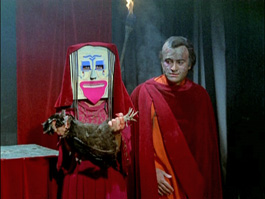 watching Vengeance of the Zombies for the plot, though. Naschy likened the movie to a drug-induced nightmare in his autobiography, and it's every bit as odd and incoherent as that suggests. This is a movie with a killer who cycles through a series of increasingly bizarre dime store fright masks...with a virtuous Indian guru squaring off against the fire-scarred evil brother who possesses him every once in a while...dueling pitchforks, bloodletting by way of beer can, chicken decapitation, voodoo-induced suicide, brutal murders with various farm implements, shamelessly gratuitous sex scenes, zombified women with beaming smiles...
watching Vengeance of the Zombies for the plot, though. Naschy likened the movie to a drug-induced nightmare in his autobiography, and it's every bit as odd and incoherent as that suggests. This is a movie with a killer who cycles through a series of increasingly bizarre dime store fright masks...with a virtuous Indian guru squaring off against the fire-scarred evil brother who possesses him every once in a while...dueling pitchforks, bloodletting by way of beer can, chicken decapitation, voodoo-induced suicide, brutal murders with various farm implements, shamelessly gratuitous sex scenes, zombified women with beaming smiles...
Sure, that kind of off-the-wall incoherence has its charm, but Vengeance of the Zombies is too scattershot, and its meager budget drags it down even further. Most of the Spanish horror films I've seen have primarily been shot outside, making use of crumbling tombs and graveyards bathed in moonlight. Vengeance of the Zombies instead spends most of its time in sparsely decorated sets, and the distractingly cheap production values and off-kilter camera angles keep the movie from ever establishing much of a creepy ambiance. Its zombies are fairly bland as well -- just bluish makeup caked on its perpetually grinning actresses' faces -- although artist Miguel Sese's work on Paul Naschy still holds up reasonably well today. The devil is featured only briefly in the movie but is so instantly memorable that he's understandably plastered across the Blu-ray set's cover art, and Kantaka's half-melted face and missing clumps of hair also hold up well to the scrutiny of high definition.
What tension there otherwise may have been in Vengeance of the Zombies is defused by the movie's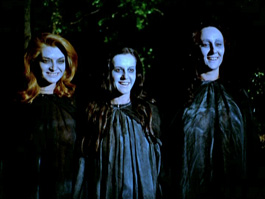 upbeat, jazzy score. There's something jarring about seeing a woman awake to the sight of zombified hands inches from her face...darting frantically around her house only to stumble upon the mutilated corpses of her loved ones...all to the tune of an uptempo lounge act that sounds like they play the Ramada by the airport every Thursday. I don't really get the impression that Vengeance of the Zombies was trying to establish some ominous sense of dread, although I'll also admit to having no idea what it's going for, exactly. Still, a disjointed, chaotic near-miss can be more fun to watch than something bland and conventional, and even if I can't exactly recommend Vengeance of the Zombies as a movie, Eurocult completists will likely find it at least worth a rental.
upbeat, jazzy score. There's something jarring about seeing a woman awake to the sight of zombified hands inches from her face...darting frantically around her house only to stumble upon the mutilated corpses of her loved ones...all to the tune of an uptempo lounge act that sounds like they play the Ramada by the airport every Thursday. I don't really get the impression that Vengeance of the Zombies was trying to establish some ominous sense of dread, although I'll also admit to having no idea what it's going for, exactly. Still, a disjointed, chaotic near-miss can be more fun to watch than something bland and conventional, and even if I can't exactly recommend Vengeance of the Zombies as a movie, Eurocult completists will likely find it at least worth a rental.
Video: I spent a good bit of time comparing this Blu-ray double feature to the original DVDs, and neither movie manages to benefit much from the upgrade to 1080p. Despite some mastering hiccups, I was really impressed with how well Vengeance of the Zombies turned out on DVD, but its release on Blu-ray is a disaster. Brightness has been cranked up excessively, destroying the contrast and even leaving the pillarboxing bars on the 1.37:1 image looking like an anemic, milky shade of gray. This is so ineptly handled that the opening credit sequence is unwatchable; it's set in a graveyard at night, but the entire image is a bright silver. Neither the DVD nor the alternate credits in the extras are botched in this way. I spotted some mild noise reduction on the DVD release, but its presence is much more glaring in high definition. There's a very, very modest increase in crispness and clarity, but there's borderline-zero appreciable difference in fine detail. Whatever benefit there may have been has been digitally smoothened out. Motion can be somewhat jittery, and the same particularly jarring instances of ghosting from the DVD release creep into the Blu-ray set as well:
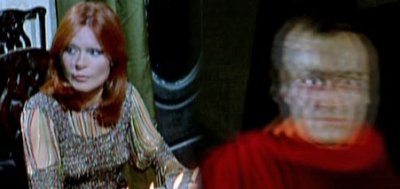
Vengeance of the Zombies was clearly shot full aperature and intended to be matted. The framing feels much more comfortable at 1.85:1, and it's unfortunate that the licensor didn't provide BCI/Deimos with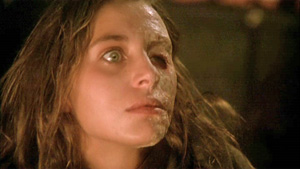 a proper widescreen master.
a proper widescreen master.
The Night of the Werewolf seems to have been hit with some noise reduction as well, but the soft, diffused look to its photography leaves it much less apparent in this half of the double feature. I'm a great fan of Alejandro Ulloa's golden, candlelit cinematography, but this 1080p version is virtually indistinguishable from the DVD release.
Audio: Neither movie features any sort of lossless audio, instead carrying over the same lackluster soundtracks from the original DVDs. Both halves of the double feature include the original Castillian audio (mono for Vengeance of the Zombies and stereo for The Night of the Werewolf) along with monaural English dubs and English 5.1 remixes. Even though the Castillian audio suffers from its share of problems -- a persistent hiss, background noise, and an overall flat, lifeless quality -- it's a definite improvement over the horrific English dubbing. Listenable but not much more than that.
Extras: This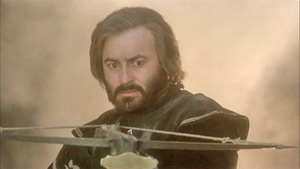 Blu-ray double feature carries over all of the disc-based extras from the 2006 DVD editions, although despite what the packaging claims, the liner notes from Mirek Lipinski (The Mark of Naschy) have been tossed aside.
Blu-ray double feature carries over all of the disc-based extras from the 2006 DVD editions, although despite what the packaging claims, the liner notes from Mirek Lipinski (The Mark of Naschy) have been tossed aside.
Paul Naschy briefly introduces each movie, and his ominous intros are the only standard definition extras in the set. Both movies include the credits from the original Spanish releases along with trailers and extensive still galleries. Vengeance of the Zombies also offers fully clothed versions of some of the nude scenes from the movie proper, and The Night of the Werewolf features a pair of deleted scenes revolving around the "preacher" and his companion. An introductory note explains why these dialogue-heavy scenes weren't re-incorporated back into the movie. Each scene opens in English and segues into the 1.66:1 pillarboxed Spanish material.
Each movie is presented on its own individual BD-25 disc. The cover features cropped versions of Wes Benscoter's outstanding artwork, and the slickly-designed animated menus from the DVD set have been upgraded to high definition as well.
Conclusion: Vengeance of the Zombies isn't much of a horror film, but its giallo underpinnings and persistent strangeness manage to be somewhat endearing even if the threadbare production values and clumsy storytelling continually fumble. The double feature is redeemed by The Night of the Werewolf, a stylish throwback to Hammer's brand of gothic horror. This Blu-ray set is such a marginal step-up in quality -- and even that might be too generous -- that they're not worth upgrading over the original DVDs, but for Eurocult enthusiasts who missed out on these movies the first time around, this Blu-ray double feature costs virtually the same as buying either of the DVDs individually.
The usual image disclaimer: the photos scattered around this review have been culled from the DVD releases and don't necessarily represent the presentation on this Blu-ray set.
The first half of Deimos Entertainment's Spanish
 horror double feature is The Night of the Werewolf (El Retorno del Hombre Lobo), the eighth installment in Paul Naschy's long-running and loosely-connected series about the lycanthropic Count Waldemar Daninsky. Naschy himself stepped behind the camera as director to bring this mainstay of 1970s Eurohorror into the '80s, but in stark contrast to the post-modern take on the mythos in An American Werewolf in London and the darkly comedic The Howling that would follow a year later, Naschy's approach instead owes more to the traditional, gothic horror of decades past.
horror double feature is The Night of the Werewolf (El Retorno del Hombre Lobo), the eighth installment in Paul Naschy's long-running and loosely-connected series about the lycanthropic Count Waldemar Daninsky. Naschy himself stepped behind the camera as director to bring this mainstay of 1970s Eurohorror into the '80s, but in stark contrast to the post-modern take on the mythos in An American Werewolf in London and the darkly comedic The Howling that would follow a year later, Naschy's approach instead owes more to the traditional, gothic horror of decades past. The Night of the Werewolf is in large part a glossier version of Werewolf Shadow, which Naschy had starred in and co-written nearly a full decade earlier. The movie opens at the dawn of the 17th century as the bloodthirsty Countess Elizabeth Bathory (Julia Saly) is sentenced to a slow, agonizing death. Daninsky, her lycanthropic slave, meets a similarly grisly end and is eager to have his torment at long last draw to a close. Daninsky's corpse is left in peace for centuries until a pair of graverobbers remove the silver cross lodged in his chest, reviving the beast and sparking another reign of terror across the Hungarian countryside.
Three nubile aspiring archaeologists stumble upon Daninsky, who remains in human form until the next full moon and has somehow taken to living in a castle. Karen (the breathtakingly beautiful Azucena Hernández) instantly falls for the Count, and her love holds the key to once again ending his curse. Erika (Silvia Aguilar), meanwhile, is fascinated with a different sort of monster, determined to
 uncover Bathory's tomb and revive the vampiress with the spilled blood of her friends. Bathory and her insatiable minions ravage the countryside and vow to return Daninsky to their thrall, a necessary step in amassing the power to cloak the world in darkness.
uncover Bathory's tomb and revive the vampiress with the spilled blood of her friends. Bathory and her insatiable minions ravage the countryside and vow to return Daninsky to their thrall, a necessary step in amassing the power to cloak the world in darkness. I have to admit to not thinking much of some of the earlier films in the series when I first saw them years ago, and I'm sure I would've had much the same reaction to The Night of the Werewolf at the time. The pacing is slower and more deliberate than the bulk of the werewolf movies I grew up with, and Daninsky is rarely seen fully transformed. It's really not difficult at all to argue that despite their titles, Werewolf Shadow and The Night of the Werewolf are better described as vampire films than werewolf movies, and they aren't drenched in blood by either standard. Seeing these movies again through somewhat older eyes, I have a much greater appreciation for them now, and The Night of the Werewolf is by far the best of the lot.
The Night of the Werewolf owes much of its success to the look of the film. Naschy and cinematographer Alejandro Ulloa share a keen visual eye, and this film had the luxury of enough time and money to be artful in a way that previous installments lacked. Its earlier moments root the film in a particular time and place -- the blame goes to some bikini-clad, poolside exposition and the girls' arrival by car -- but once the story gets underway, The Night of the Werewolf deftly transforms itself into gothic horror, set entirely in torchlit castles and dusty underground crypts. Change out some of
 the wardrobe and it could just as easily be taking place a hundred years earlier. Comparisons to Hammer's monster revivals of the '60s are unavoidable but well-deserved, not just in terms of the story and cinematography but the make-up effects as well. The latex and air-bladders that would earn An American Werewolf in London an Oscar for its effects were only a year away, but The Night of the Werewolf prefers grease paint and spirit gum, following the various stages of Daninsky's transformations with time-lapsed camera fades. The look of its vampires has also been improved over Werewolf Shadow, trimming down the cartoonishly long fangs to something more subtle and effective.
the wardrobe and it could just as easily be taking place a hundred years earlier. Comparisons to Hammer's monster revivals of the '60s are unavoidable but well-deserved, not just in terms of the story and cinematography but the make-up effects as well. The latex and air-bladders that would earn An American Werewolf in London an Oscar for its effects were only a year away, but The Night of the Werewolf prefers grease paint and spirit gum, following the various stages of Daninsky's transformations with time-lapsed camera fades. The look of its vampires has also been improved over Werewolf Shadow, trimming down the cartoonishly long fangs to something more subtle and effective. There are a number of sequences that still hold up exceptionally well today, particularly the revival of Bathory; as blood oozes from a naked, lifeless body suspended above, smoke streams from the stone likeness of the Countess that adorns her tomb. Admittedly, the storytelling has its clumsier moments, some of the film's effects probably looked dated even when The Night of the Werewolf was first released nearly thirty years ago, and its slower pace and restrained violence may bore viewers weaned on bloodier, more brutal movies. To me, at least, The Night of the Werewolf is such a finely crafted homage to classic horror that what might be viewed as shortcomings to some are an essential part of its appeal. Highly Recommended.
Vengeance of the Zombies
In the introduction
 that opens this Blu-ray disc, writer and star Paul Naschy twice describes Vengeance of the Zombies (La Rebelión de las Muertas) as strange, and...yes, "una pelicula extraña" would certainly be one way to put it.
that opens this Blu-ray disc, writer and star Paul Naschy twice describes Vengeance of the Zombies (La Rebelión de las Muertas) as strange, and...yes, "una pelicula extraña" would certainly be one way to put it. The liner notes in its initial DVD release on these shores described this 1972 slice of Eurocult as a mix of a German krimi and a zombie film. I can't claim to be all that familiar with krimi, but if Vengeance of the Zombies is any indication, it's not too far removed from the Italian giallo. A masked killer on a deranged search for revenge is hunting his prey throughout the English countryside, and with each woman he kills, he adds another member to his arsenal of the walking undead. These are zombies in the classic sense, re-animated by voodoo rather than some sort of cannibalistic plague, and their etherial, dreamlike movements owe more to the Templars in the Blind Dead series than the flesh-eaters of Let Sleeping Corpses Lie. The plot mixes in the undead, Satanic nightmares, and Indian mysticism with such giallo mainstays as graphic stabbings, a masked and blood-spattered whodunnit, a thirst for vengeance, exposition-riddled exchanges at Scotland Yard, the hapless woman caught in the middle, and the lone gun determined to uncover the truth.
No one's really
 watching Vengeance of the Zombies for the plot, though. Naschy likened the movie to a drug-induced nightmare in his autobiography, and it's every bit as odd and incoherent as that suggests. This is a movie with a killer who cycles through a series of increasingly bizarre dime store fright masks...with a virtuous Indian guru squaring off against the fire-scarred evil brother who possesses him every once in a while...dueling pitchforks, bloodletting by way of beer can, chicken decapitation, voodoo-induced suicide, brutal murders with various farm implements, shamelessly gratuitous sex scenes, zombified women with beaming smiles...
watching Vengeance of the Zombies for the plot, though. Naschy likened the movie to a drug-induced nightmare in his autobiography, and it's every bit as odd and incoherent as that suggests. This is a movie with a killer who cycles through a series of increasingly bizarre dime store fright masks...with a virtuous Indian guru squaring off against the fire-scarred evil brother who possesses him every once in a while...dueling pitchforks, bloodletting by way of beer can, chicken decapitation, voodoo-induced suicide, brutal murders with various farm implements, shamelessly gratuitous sex scenes, zombified women with beaming smiles... Sure, that kind of off-the-wall incoherence has its charm, but Vengeance of the Zombies is too scattershot, and its meager budget drags it down even further. Most of the Spanish horror films I've seen have primarily been shot outside, making use of crumbling tombs and graveyards bathed in moonlight. Vengeance of the Zombies instead spends most of its time in sparsely decorated sets, and the distractingly cheap production values and off-kilter camera angles keep the movie from ever establishing much of a creepy ambiance. Its zombies are fairly bland as well -- just bluish makeup caked on its perpetually grinning actresses' faces -- although artist Miguel Sese's work on Paul Naschy still holds up reasonably well today. The devil is featured only briefly in the movie but is so instantly memorable that he's understandably plastered across the Blu-ray set's cover art, and Kantaka's half-melted face and missing clumps of hair also hold up well to the scrutiny of high definition.
What tension there otherwise may have been in Vengeance of the Zombies is defused by the movie's
 upbeat, jazzy score. There's something jarring about seeing a woman awake to the sight of zombified hands inches from her face...darting frantically around her house only to stumble upon the mutilated corpses of her loved ones...all to the tune of an uptempo lounge act that sounds like they play the Ramada by the airport every Thursday. I don't really get the impression that Vengeance of the Zombies was trying to establish some ominous sense of dread, although I'll also admit to having no idea what it's going for, exactly. Still, a disjointed, chaotic near-miss can be more fun to watch than something bland and conventional, and even if I can't exactly recommend Vengeance of the Zombies as a movie, Eurocult completists will likely find it at least worth a rental.
upbeat, jazzy score. There's something jarring about seeing a woman awake to the sight of zombified hands inches from her face...darting frantically around her house only to stumble upon the mutilated corpses of her loved ones...all to the tune of an uptempo lounge act that sounds like they play the Ramada by the airport every Thursday. I don't really get the impression that Vengeance of the Zombies was trying to establish some ominous sense of dread, although I'll also admit to having no idea what it's going for, exactly. Still, a disjointed, chaotic near-miss can be more fun to watch than something bland and conventional, and even if I can't exactly recommend Vengeance of the Zombies as a movie, Eurocult completists will likely find it at least worth a rental. Video: I spent a good bit of time comparing this Blu-ray double feature to the original DVDs, and neither movie manages to benefit much from the upgrade to 1080p. Despite some mastering hiccups, I was really impressed with how well Vengeance of the Zombies turned out on DVD, but its release on Blu-ray is a disaster. Brightness has been cranked up excessively, destroying the contrast and even leaving the pillarboxing bars on the 1.37:1 image looking like an anemic, milky shade of gray. This is so ineptly handled that the opening credit sequence is unwatchable; it's set in a graveyard at night, but the entire image is a bright silver. Neither the DVD nor the alternate credits in the extras are botched in this way. I spotted some mild noise reduction on the DVD release, but its presence is much more glaring in high definition. There's a very, very modest increase in crispness and clarity, but there's borderline-zero appreciable difference in fine detail. Whatever benefit there may have been has been digitally smoothened out. Motion can be somewhat jittery, and the same particularly jarring instances of ghosting from the DVD release creep into the Blu-ray set as well:

Vengeance of the Zombies was clearly shot full aperature and intended to be matted. The framing feels much more comfortable at 1.85:1, and it's unfortunate that the licensor didn't provide BCI/Deimos with
 a proper widescreen master.
a proper widescreen master. The Night of the Werewolf seems to have been hit with some noise reduction as well, but the soft, diffused look to its photography leaves it much less apparent in this half of the double feature. I'm a great fan of Alejandro Ulloa's golden, candlelit cinematography, but this 1080p version is virtually indistinguishable from the DVD release.
Audio: Neither movie features any sort of lossless audio, instead carrying over the same lackluster soundtracks from the original DVDs. Both halves of the double feature include the original Castillian audio (mono for Vengeance of the Zombies and stereo for The Night of the Werewolf) along with monaural English dubs and English 5.1 remixes. Even though the Castillian audio suffers from its share of problems -- a persistent hiss, background noise, and an overall flat, lifeless quality -- it's a definite improvement over the horrific English dubbing. Listenable but not much more than that.
Extras: This
 Blu-ray double feature carries over all of the disc-based extras from the 2006 DVD editions, although despite what the packaging claims, the liner notes from Mirek Lipinski (The Mark of Naschy) have been tossed aside.
Blu-ray double feature carries over all of the disc-based extras from the 2006 DVD editions, although despite what the packaging claims, the liner notes from Mirek Lipinski (The Mark of Naschy) have been tossed aside. Paul Naschy briefly introduces each movie, and his ominous intros are the only standard definition extras in the set. Both movies include the credits from the original Spanish releases along with trailers and extensive still galleries. Vengeance of the Zombies also offers fully clothed versions of some of the nude scenes from the movie proper, and The Night of the Werewolf features a pair of deleted scenes revolving around the "preacher" and his companion. An introductory note explains why these dialogue-heavy scenes weren't re-incorporated back into the movie. Each scene opens in English and segues into the 1.66:1 pillarboxed Spanish material.
Each movie is presented on its own individual BD-25 disc. The cover features cropped versions of Wes Benscoter's outstanding artwork, and the slickly-designed animated menus from the DVD set have been upgraded to high definition as well.
Conclusion: Vengeance of the Zombies isn't much of a horror film, but its giallo underpinnings and persistent strangeness manage to be somewhat endearing even if the threadbare production values and clumsy storytelling continually fumble. The double feature is redeemed by The Night of the Werewolf, a stylish throwback to Hammer's brand of gothic horror. This Blu-ray set is such a marginal step-up in quality -- and even that might be too generous -- that they're not worth upgrading over the original DVDs, but for Eurocult enthusiasts who missed out on these movies the first time around, this Blu-ray double feature costs virtually the same as buying either of the DVDs individually.
The usual image disclaimer: the photos scattered around this review have been culled from the DVD releases and don't necessarily represent the presentation on this Blu-ray set.
|
| Popular Reviews |
| Sponsored Links |
|
|
| Sponsored Links |
|
|
| Release List | Reviews | Shop | Newsletter | Forum | DVD Giveaways | Blu-Ray | Advertise |
|
Copyright 2024 DVDTalk.com All Rights Reserved. Legal Info, Privacy Policy, Terms of Use,
Manage Preferences,
Your Privacy Choices | |||||||













